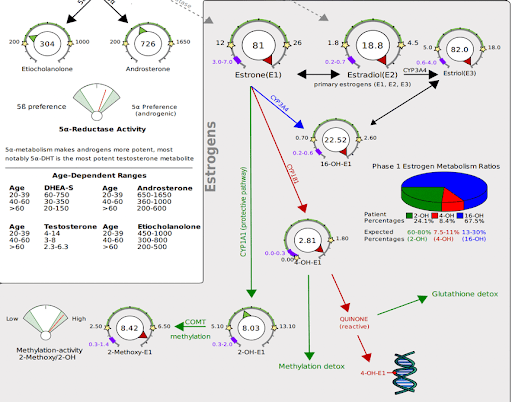Janet is 45 years old and recently began to notice some changes in her body that have her worried and confused. Her periods, once a clockwork 28 days apart, are now happening every 2 weeks, and she describes them as a “crime scene.” Her breasts are sore and swollen for at least 2 weeks of the month. She’s gaining weight even though she lives a very healthy lifestyle. And sleep? She’s forgotten what it feels like to wake up refreshed and energized. She’s barely dragging through her day.
This scenario is all-too-common with my clients and generally points to levels of estrogen that are out of balance with progesterone. When you enter perimenopause, you stop ovulating every month, which causes levels of progesterone to fall. This allows estrogen to run the show in your body all month. Unfortunately, it also results in the symptoms I just described above. This situation is often called “estrogen dominance.” You can learn more about the basics here.
 But there’s more to understanding what’s going on with estrogen than the ratio of estrogen to progesterone. You also need to understand how your body processes estrogen and how those metabolites contribute to your cancer risk and problems with estrogen dominance.
But there’s more to understanding what’s going on with estrogen than the ratio of estrogen to progesterone. You also need to understand how your body processes estrogen and how those metabolites contribute to your cancer risk and problems with estrogen dominance.
Your body actually makes 3 kinds of estrogen:
- Estrone
- Estradiol (about 80% of what circulates in your body)
- Estriol (the weakest form and produced in large quantities during pregnancy)
Your liver metabolizes each of the forms in a 2-phase process called sulfation and glucuronidation.
Let’s Take a Look at The Metabolites of These 3 Estrogens:
The first estrogen metabolite to discuss is the 2-hydroxyestrone metabolite (2-OH). The 2-hydroxyestrone metabolite is the product of several liver detoxification enzymes. Evidence points to the 2-hydroxyestrone metabolite as perhaps the “safest” estrogen metabolite, so it earns the label of “good” estrogen, although it is not without potential problems. 2-hydroxyestrone is the least associated with DNA damage that causes cancer and has the weakest estrogenic effect. Deactivated by methylation in Phase 2, this metabolite ultimately leaves the body through bowel movements.
The second estrogen metabolite to discuss is the 4-hydroxyestrone metabolite. The 4-OH estrone metabolite is again the result of processing by liver enzymes. It then becomes detoxified by glutathione, a powerful antioxidant. According to most research, the 4-hydroxy estrone comes with an increased risk of cancer initiation and cancer growth. It causes the most DNA damage, has the strongest estrogenic effect, and binds very tightly to the estrogen receptors. It is the “ugly” estrogen.
The third estrogen metabolite is the 16-hydroxyestrone (16-OH) metabolite. Historically, the 16-OH metabolite is the “bad” estrogen metabolite in the “the good, the bad, the ugly” trio. Higher levels of the 16-OH metabolite can cause heavy periods, breast tenderness, breast cancer, obesity, hypothyroidism, pesticide toxicity (organochlorines), high omega-6 fatty acids, and inflammatory cytokines. It causes DNA damage and binds tightly to the estrogen receptors. Like the 4-OH metabolite, it inhibits programmed cell death which leads abnormal cells to grow continuously.
What Can Go Wrong?
In many women, these metabolites get out of balance because of an issue with Phase 1, 2, or 3 of the process. Phase 1 is like water running into a bathtub. As long as the drain is open, water (or estrogen) can move to the next phase. But if Phase 1 is sluggish due to liver enzymes that are not operating optimally or inhibited pathways, the estrogen can’t get into Phase 2. This backs up the metabolites, worsening problems with estrogen dominance.
In some women, the drain is open, and the estrogen moves easily into Phase 2. But if the COMT pathway is slow, the estrogen metabolites will recirculate because they are unable to be methylated for elimination. A number of supplements — such as TMG, calcium d-glucarate, etc. — can support this process.
The third scenario that creates a problem is constipation. Estrogen is ultimately eliminated in bowel movements (Phase 3), so constipation backs up the whole system. When addressing the issue of poor balance of metabolites, Phase 3 must be addressed first.
Measuring Your Estrogen Metabolites
Fortunately, these metabolites can be measured in urine, allowing manipulation of the pathways to encourage metabolites to be pushed into the 2-OH pathway and improve overall detoxification. By using a urine test, it shows not only the metabolites but how well you are methylating the metabolites through the COMT pathway for elimination through bowel movements.
Here’s what this looks like on a DUTCH test:

In this client, Phase 1 estrogen metabolites are very out of balance. Clearly, she has significant estrogen dominance (as noted by estrone, estradiol, and estriol levels). Additionally, an overabundance of the 16-OH metabolite characterizes her breakdown in Phase 1. This manifests as excess weight, heavy periods, and extreme breast tenderness.
Her methylation in Phase 2 is very good. However, the problem is that her metabolites in Phase 1 appear backed up. Addressing this issue with foods like broccoli sprouts or supplements such as DIM, quercetin, or trans-resveratrol will give her rapid relief from her symptoms.
To Conclude
If you’re wondering how to manage estrogen metabolites that are out of balance, stay tuned for next week’s post. I’ll cover that then!
If you’re interested in learning more about your overall hormone levels and metabolites, consider my Connect the Dots program. Our team can create a customized management plan for you and provide coaching to help you implement our recommendations. You can sign up for that here or email me for more information at info@drannagarrett.com.
Dr. Anna Garrett is a menopause expert and Doctor of Pharmacy. She helps women who are struggling with symptoms of perimenopause and menopause find natural hormone balancing solutions so they can rock their mojo through midlife and beyond. Dr. Anna is the author of Perimenopause: The Savvy Sister’s Guide to Hormone Harmony. Order your copy at www.perimenopausebook.com.
Dr. Anna is available for 1-1 consultation. Find out more at www.drannagarrett.com/lets-talk





